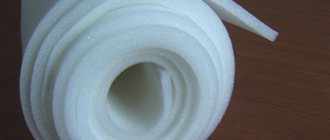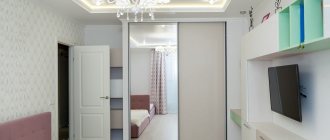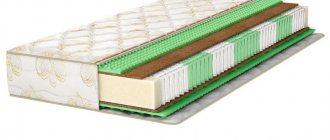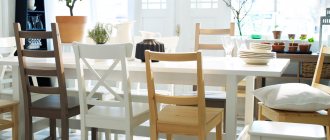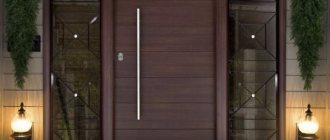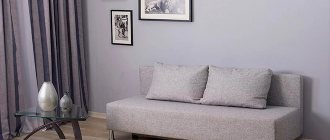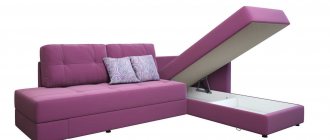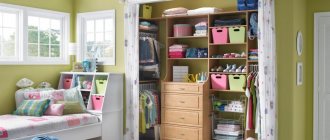Which foam rubber to choose for upholstered furniture?
In order not to have to repair upholstered furniture regularly, you should take care in advance about choosing high-quality materials. This applies not only to the upholstery, but also to the filler, which makes the furniture comfortable, soft, and comfortable.
Advantages
Foam rubber (its other names are polyurethane foam, polyurethane foam) is a modern filler, which is a foamed mixture of various polymers. Due to the high air content in thin-walled microcells, polyurethane foam is elastic, resilient, and durable.
Advantages of the material:
- Resistant to mold;
Hygienic;
Does not emit dust or accumulate it;
Hypoallergenic;
Safe.
Thanks to its elasticity, furniture foam rubber provides maximum comfort during use. A high-quality filler lasts for several years without changing its characteristics.
Varieties
Sufficient density and elasticity are important requirements for the filler of upholstered furniture. If the sofa will play the role of a sleeping place, it is better to choose harder foam rubber - doctors do not recommend surfaces that are too soft for sleeping. If the furniture is intended primarily for rest and relaxation, you may prefer less rigidity. It all depends on the taste of the furniture owners.
The density of foam rubber used for upholstered furniture must be at least 30 kg/m³. Many manufacturers of polyurethane foam recommend using foam rubber with a density of less than 35 kg/m³ for heavily loaded upholstered furniture seats. Since the denser the polyurethane foam, the more expensive it is, this recommendation is often ignored in furniture factories. As a result, after a couple of years of use, the filling becomes deformed, the sofa becomes lumpy and uncomfortable.
Foam rubber of increased rigidity is optimally suited; it is designated by the code EL. A more budget-friendly and significantly less reliable option is standard foam rubber (code ST). As a rule, it is used for inexpensive upholstered furniture - this explains the fact that sofas or armchairs sometimes lose their shape after just a couple of years of use.
For backrests, and even more so for armrests, the load on which is much less than on the seats, you can choose lower-density foam rubber. As for the thickness of the material, it is better if it is at least three, even four centimeters.
Only specialists can visually determine the type of foam rubber, while others can focus on its type and brand. The type is indicated in Latin letters (ST - standard, HL - hard, HR - with high elasticity, etc.) Brand - four numbers. The first two indicate density (the density value of standard polyurethane foam for furniture seats is allowed to be at least 30), the second two indicate rigidity.
Replacing foam rubber
If new furniture seems uncomfortable, it is likely that this is caused by insufficient quality filling. Replacing polyurethane foam allows you to solve this problem at minimal cost. You can also change the foam in furniture that has already served its owners well. This type of repair goes well with replacing the upholstery.
What filler
is it better to choose for the sofa
?
The answer to this question will depend on the desired degree of rigidity and the purpose of the piece of furniture.
For example, if you choose, then the characteristics of its internal filling will be significantly different from the characteristics of the filling of the sofa that will be in the living room or.
The service life
depend
on what is under the upholstery . Let's take a closer look at all the possible options.
Spring block
This option is used
for
many years
and to this day.
Its main advantage
is a high level of comfort, correct and uniform distribution of a person’s weight both in a sitting and lying position.
There are two types
of spring fillers:
dependent,
called
“Bonnel”
and
independent
, called
“Pocket spring”.
To the main advantages
spring blocks include:
- Long service life
with proper quality of workmanship; - Reliability;
- Ability to withstand
significant
loads; - The surface
of the sofa will be
smooth,
without dents; - Elasticity
and sufficient rigidity, which can be selected depending on the number of springs and their density; - Possibility of free air circulation,
which will prevent the appearance of various insects; - Orthopedic properties
that your spine will appreciate.
Flaws,
Of course, there are also:
- Over time, squeaking may occur;
- Independent blocks have a high cost;
- If one or more springs break, repairs
can
be
quite
expensive;
Polyurethane foam
PPU
is
a synthetic,
highly porous foam
material
that is obtained by mixing several synthetic polymers.
In its density it can exceed materials such as rubber and caoutchouc. This indicator affects the quality of polyurethane foam products. For furniture, polyurethane foam is usually used with an indicator of 30 to 40 kg per square meter. The higher this indicator, the more durable
the product will be.
Material with an index of less than 30 units is used only for the manufacture of decorative pillows. To find out what filler density your chosen model has, you need to ask for a passport
for the product.
For factory furniture this parameter will definitely be indicated. The technology for producing
this material is quite simple, which has a positive effect on its cost.
There are two types
PPU:
For the manufacture of various elements of the sofa, sheets of different degrees of rigidity are used. Products made from polyurethane foam are not tolerated
exposure to direct
sunlight.
Under their influence, they can crumble, so mattresses made of this material are additionally
protected with covers
made of light-proof fabric.
An interesting feature of some PU foam compositions is that they have a shape memory effect.
Usually from it, they remember the contours of the human body and adapt to them as much as possible. But as soon as you get up, the pillow will instantly return to its original state.
A product filled with high-quality polyurethane foam will be more affordable in price than
“Pocket spring”
block but in terms of its properties and level of comfort approximately the same.
This mattress can also be used for sleeping.
"Bonnel" will be cheaper than both of these options and significantly worse in technical characteristics.
To the benefits
PPU can be classified as:
- Long
service life; - Absolute safety
and environmental friendliness of the material; - Good balance of softness/hardness;
- Air
and
moisture permeability; - The material does not provoke allergic reactions;
- Does not accumulate dust;
- Rapid restoration of shape
after deformation due to high elasticity; - Ability to withstand significant loads
for long periods of time.
Disadvantages
this material has significantly
less:
- Cheap polyurethane foam
quickly loses its elastic properties, which is why dents will soon appear in places of greatest load: - Some types of polyurethane foam may seem quite rigid
compared to a spring block.
Sintepon
Very common
material that is used as filler in
inexpensive models.
It is a synthetic material in the form of a non-woven fabric.
It is made from polyester fibers. The best option
would be to use it in combination with other types of filler.
Usually it serves as an intermediate layer
between full filler material, such as polyurethane foam, and upholstery.
It gives the finished product additional softness and elasticity. The advantages
of padding polyester include:
- Low cost;
- is environmentally friendly
, due to which it is not prone to the appearance of fibers inside; - Despite its synthetic origin, synthetic winterizer does not cause allergies
and can be used as a filler even for; - Its structure
is elastic and
resilient.
Despite all the positive qualities, it has a number of significant disadvantages:
- The most important one is the short operating period.
With active use and frequent loads, this material loses its elastic properties, and dents and irregularities quickly form on the surface of the product. Therefore, despite the affordable cost, furniture filled with padding polyester will last a very short period. - At the moment there is no unified production technology for this material. Therefore, you risk purchasing a low-quality product,
in the manufacture of which harmful substances could be used. To avoid this, be sure to ask the seller for a certificate for the product, which can confirm its safety. - As a full-fledged filler, it can be used only for pillows or armrests, in some cases for the backrest, in order to give it decorative bends or protrusions. For example, if the back of the sofa is made using the “carriage screed” technology;
- Over time it clumps
into clumps.
Having assessed the advantages and disadvantages, we can come to the conclusion that such material is better suited for a sofa,
which will be used in
the living room.
Which mattress is better - cotton, plain foam or polyurethane foam?
Cotton mattress pros and cons, service life
In this product, the ratio of long and short fibers is important (a product with short fibers makes it flat, but reduces weight). Short fibers make the mattress feel heavier.
Advantages : natural material, heat retention and environmental friendliness
Flaws:
- quick dumping of the filler into lumps
- quickly lose their appearance
- are pressed through after 2–3 months of constant sleep
- poorly ventilated
- it harbors harmful microorganisms
- bad for the spine
- may deform posture
For reference : Duration of service life: 5 years.
Foam mattress pros and cons
Mattresses based on foam rubber are very easy to transport; they are light and compact. They have high elasticity and softness.
They are quickly pressed, but the filler does not get lost in them. They are very sensitive to moisture from the human body; under the influence of liquid, foam rubber quickly collapses.
If an open fire occurs, such a mattress will quickly catch fire, and the mattress itself will last no more than 5 years.
Polyurethane foam mattress pros and cons
The filler used for the mattress is a synthetic analogue of the well-known latex. It has a microstructure of small cells. Visually it resembles foam rubber, but has better quality.
The service life of such a product is longer than that of the above. It is better in quality than cotton wool and is more comfortable to sleep on. A latex mattress has orthopedic properties. The cost of such mattresses is low.
Flaws:
- not completely hypoallergenic
- crumbles over time
- more rigid than natural latex, especially at the beginning of use
- It's hot to sleep on
- pressed to the shape of the sleeping person’s body (after 3 years of use)
- heavy.
Based on all of the above, we can conclude that a cotton mattress is a convenient budget option for a short period of time . It can serve when you need a mattress, but it is not possible to buy a more expensive analogue with high-quality filling.
Important! In the long term, it can cause a lot of harm to health, because it is poorly ventilated and does not have an orthopedic effect. It may cause allergies. In everyday life, such a mattress is not very comfortable due to its heaviness.
But if you decide to buy just such a mattress, then you should pay attention to the quality of the stitching, the naturalness of the filler, and the material from which the cover is made.
Periotec
This is modern
non-woven
material,
which consists of high quality polyester fibers.
It is increasingly used for the manufacture of mattresses and various bedding, as well as for filling. Thanks to special additives
in the form of artificial components (for example, corn fibers, bamboo or viscose), or natural fibers (wool, coconut, linen or cotton), this material
has
high
strength
and elasticity.
Along with these indicators, the service life of products with such filler also increases. To strengthen
the perioteca, knitted fabric can be additionally used - dublerin, non-woven single-stitched or needle-punched fabric or woven fabric, such as calico.
To understand exactly what components are included in the composition and what level of hardness this filler can provide, it has a special marking.
It also indicates the density and width.
To obtain this material, which is still unusual for us, a special technology is used.
It consists of the formation
of three
different
layers.
The first layer is the main one, it must bear the entire load.
Its fibers are laid in a vertical direction and fixed in this position under the influence of high temperature. The second
and
third
layers serve as reinforcement.
They strengthen and support the first layer. This unique structure
explains the high technological performance of this type of filler.
Advantages
perioteca are obvious:
- The material is hypoallergenic;
- In its structure,
of harmful and pathogenic
microorganisms is impossible - It is completely safe
for human health. This is explained by the fact that its composition does not contain glue, resins and other components that can be toxic. The fibers are bonded under the influence of temperature. - Periotec mattresses provide a very high level of comfort;
- Able to restore shape with a small indicator of residual deformation
even under prolonged exposure to significant loads;
Its elasticity
indicator are similar to
those of an independent
spring unit;- Durability,
thanks to a three-layer reinforced structure; - Air permeability;
- Fire safety.
To the disadvantages
can be attributed:
- The cost
is equal to the cost of the “Pocket spring” block. - This material is ideal for filling upholstered furniture, but may be too hard for some.
In such cases, it is used as the main, elastic layer, and to achieve a lower degree of rigidity, softer materials are additionally used.
This sofa can be used for
daily
sleep.
After all, the degree of its deformation is practically reduced to a minimum.
Struttofiber
One of the most resilient
types of modern fillers, which is ideal for filling upholstered furniture.
Its second name, “non-woven independent springs,”
speaks for itself.
It is made from synthetic and natural fibers such as cotton, linen, coconut, camel hair or combinations thereof. The manufacturing technology
is reminiscent of the process for obtaining Periotec.
The carrier layer fibers are also laid vertically and fixed using a stream of very hot air. This technology is called “strutto”. Thanks to this, the finished material has increased elasticity and wear resistance. It is
able to accurately
adapt to the contours
of the body and prevent problems with the musculoskeletal system.
Struttofiber has a number of significant advantages:
- It is not subject to rotting;
Its
service life
is very long;- Due to increased elasticity, it restores shape
after prolonged loads; - Withstands
heavy
weights; - Does not absorb moisture;
- Does not support
process
; - Breathable;
Dust
mites
and other microorganisms cannot appear in this material- Hypoallergenic;
- Does not produce
unnecessary noise or
squeaks; - Has a reasonable price.
It is necessary to select the correct stiffness for different weight categories, for example:
- Filler with a high hardness index
is recommended for people weighing 90 kg or more; - The average level
of rigidity can withstand loads weighing from 60 kg to 90 kg; - Soft
filler is recommended for use by people whose weight does not exceed 60 kg.
Due to such weight restrictions, difficulties
when choosing among older people who are uncomfortable sleeping or sitting on a hard surface, but whose weight exceeds the permissible norms.
Felt and padded jacket
Felt is a non-woven material of natural origin,
which is obtained from felted goat or sheep wool.
The structure of these types of wool makes it possible to obtain a very dense material, the formation of which uses high-temperature pressing. It is rolled through hot cylinders, after which a fairly strong and hard crust is obtained on both sides of the sheet. Felt is produced in the form of panels that have different thicknesses. The quilted jacket
is
a composition
of cotton wool, the layer of which is 5 cm thick and dense fabric that covers it on both sides. It can be investment, bag, gauze fabric or technical calico. To connect all layers to each other, use machine stitching with dense threads at a certain interval.
These two materials are not
usually used
as
100%
filler due to their excessive density
. However, felt serves as a protective layer
for spring or polyurethane foam blocks, making their surface more wear-resistant and protecting them from crushing.
This significantly increases the service life of the products. The quilted pad is used as an intermediate layer
between fillers.
It is used to increase the comfort and convenience of a sleeping place. These materials have many advantages:
- Protective properties
that increase the service life of upholstered furniture; - Natural components
in the composition that allow this filler to be used even for small children's sofas; - High
density and
wear resistance; - Affordable price;
- Hypoallergenic;
- Possibility of
uniform
load distribution; - well .
- Smooth surface
even after many years of use.
To significant disadvantages
relate:
- Natural wool can harbor insects
and other pests; - This covering absorbs moisture
and can quickly
become moldy,
which is why it needs to be constantly dried, which is extremely problematic to do when it comes to filling for a sofa.
Should I choose a cotton mattress?
It will not be an exaggeration to say that the choice of mattress fillers for sleeping today is huge - spring, springless, artificial, natural, anatomical, orthopedic, of varying degrees of hardness, using innovative technologies and materials. It seems that the range of modern products should completely replace outdated cotton models. But this doesn't happen. Cotton wool mattresses attract some consumers:
- firstly - low price;
- secondly, familiarity.
Wholesale buyers (purchasing mattresses for barracks, dormitories, budget hospitals) can be understood. As for choosing a sleeping surface for home use, there is no need to rush into buying a cotton mattress. You can consider a cotton model as an option if we are talking about:
- A very budget solution for a folding bed (in the guest version);
- buying a mattress for the dacha;
- purchasing a “futon” that is placed on the floor for watching TV.
But if we talk about a mattress for daily, full, comfortable sleep, cotton filler is not the best choice.
Reference! To be fair, it is worth noting that in Japan and the USA, cotton mattresses or futons are in demand. Futon mattresses from a series of expensive ones in the USA cost $150.
Holofiber
We can say that this is an improved padding polyester.
It resembles small fluffy balls, which are formed from polyester spiral polyester fibers and have many internal pores.
Thanks to its spiral structure
, it has a main advantage that is very much appreciated when choosing filler for upholstered furniture - it is able to quickly restore its shape after prolonged loads.
At the same time, it remains very soft
and warm.
It is actively used as a filler for sofa cushions and seats. furniture material
is used to fill the seats It looks like a mat with the same spiral structure.
It is very thick, elastic, and retains its shape well. Today it is considered one of the highest quality fillers.
This is explained by a large list of its
positive
qualities:
- Absolute safety
and environmental friendliness, which makes it possible to use it to fill children's furniture; - Does not cause allergic
reactions; - Has low weight;
- Does not absorb odors;
- Does not
absorb or collect
dust on its surface; - Easily
changes and
restores shape;
Harmful
microorganisms cannot
form in it ;- Has
high
softness
and elasticity; - Does not absorb moisture;
- Breathable;
- Does not roll down;
- Does not support combustion;
- Has a long
service life.
Significant disadvantages
This material
was not detected.
Perhaps the cost is higher than that of padding polyester.
Summing up
As sad as it is, sometimes the time comes to admit that some things, materials, technologies have outlived their usefulness and have been replaced by something new and better. A classic cotton mattress is a prime example of this.
Although cotton wool as a material has a lot of positive characteristics and in some areas it really has no equal, it has not justified itself as a filler for sleeping mattresses. Lack of orthopedic characteristics, inability to adapt to the curves of the sleeper’s body, short service life, troublesome maintenance... As you can see, there are many more disadvantages than advantages.
Foam rubber
The most affordable
in terms of cost and the lowest
quality
type of filler.
Foam rubber is the same polyurethane foam, but of the lowest quality
and lowest density.
Therefore, it is a mistake to think that these are two different materials. Very often, sellers can deceive buyers
by claiming that this is not so.
In fact, they differ only in their characteristics. By the way, the thickness of the foam rubber does not in any way affect the degree of its rigidity. Even a tall sheet can easily wrinkle and be very porous, while a thin sheet can instantly restore its shape. Foam rubber is rarely used as a filler
for soft sofas.
Perhaps, for their armrests or cowls. It has found its application as a material for .
Its positive aspects
This:
- Low cost;
Health safety- Antistatic
properties; - Hypoallergenic;
- Permits air
and moisture well - No
possibility
of mold formation.
Flaws,
unfortunately, very significant:
- Fragility;
- Low quality foam rubber very quickly loses its elastic properties,
causing dents to form on the surface; - Over time, it dries out
and
crumbles; - Not
intended
for filling furniture
that is subject to intensive use.
As you can see, such a filler will very quickly become unusable, and your sofa will quickly lose its aesthetic appearance.
Latex
This is a filler of natural origin,
which is used in expensive models of upholstered furniture.
It is made from the sap of rubber plants,
which significantly increases its cost.
When is vulcanized
, it is possible to obtain a structure that has many cells that facilitate air penetration and are responsible for hygroscopicity.
The technology for producing
latex, which is used in the furniture industry, is quite simple.
The latex mixture is poured into a container in which it is constantly mixed and foams after a certain period of time. After this, it is poured into special molds and the vulcanization process occurs at a temperature of 100°C. The resulting workpiece is removed from the mold, cleaned of unnecessary foam residues and dried at a temperature of 120°C. After this, the sheets are tested for rigidity, weighed, packaged and sent to the furniture factory. Due to the fact that rubber in its natural form does not tolerate exposure to
fat or
ultraviolet radiation
and
is destroyed
by this, special
stabilizing additives are used in the production of latex mixtures.
Thus, the maximum proportion of natural rubber in latex foam is
no more than 85%.
This product is considered completely natural.
If we talk about the requirements for filler for
upholstered
furniture,
the permissible latex content is
45-60%.
This indicator is quite
sufficient
to obtain the required level of strength, elasticity and wear resistance.
If you are not limited in finances and prefer to use furniture made from natural materials in your home, we recommend that you pay attention to this type of filler. It has a number of advantages:
- The service life
is about 20 years; - Does not cause
allergic reactions; - Breathable;
Follows the contours
as
accurately ;- Able to dampen vibration;
- Evenly distributes the load,
due to which it has orthopedic properties; - Non-toxic;
- very quickly.
To the disadvantages
can only be attributed to its
high cost,
which is due to the specifics of production and the components used.
There is also artificial latex.
This is the name of highly elastic polyurethane foam.
In order not to be deceived,
you need to know that the natural filler has a grayish tint and seems greasy to the touch. While synthetic has a yellowish tint and is dry to the touch.
Durafil
This material has a structure
which is similar in performance
to a spring block.
This is a high-quality non-woven fabric, which is made from hollow polyester fibers by heat treatment and gluing the fibers to the base.
Its fibers
are arranged
vertically
and seem to grow from the base, resembling grass.
This structure allows you to achieve high levels of elasticity combined with softness and fluffiness. This material
is
ideal for
filling
sofas,
giving their backs and seats volume and an attractive appearance.
Such furniture looks very cozy and comfortable, and in fact it is. Its advantages
make this material more popular every day:
- Hypoallergenic
material that does not contain substances that can cause even the slightest allergic reaction; - Does not support
process
.
This is due to the peculiarity of production, during which it is subjected to special heat treatment and loses its flammable properties. It may char, become deformed, or collapse completely, but it will not ignite. - High elasticity,
which was achieved thanks to vertically directed individual fibers.
Such a structure actively resists the load,
and when it disappears, the fibers immediately tend to take their original position. - This material does not accumulate dust;
- Resistant
to moisture and
temperature changes; - Has antimicrobial
properties; - It has a pleasant softness,
which makes it popular in the furniture industry; - Long service life.
Disadvantages
this material
has not yet been identified.
And, based on the list of its positive qualities, we can conclude that a sofa with such filling can be used as a full-fledged
sleeping place.
Lamels
Do not forget that if you are looking for a sofa that can also act as a sleeping place, then to achieve orthopedic properties
and extending its service life, it is necessary to choose models that are additionally
equipped with lamellas.
Of course,
this is not a type of filler
, but only additional
support
for it, which is very useful.
The slats are
veneered wood strips that have a slightly curved shape.
This design allows you to compensate for the load and ensure correct body position. When pressed, they bend, allowing the load to be evenly distributed. The material used is birch, poplar or beech. The thickness of the lamellas is 2-10 mm. It is clear that the thicker this element and the more often it is located on the frame, the stronger and more durable it will be. The disadvantage of
the slats is that if they break, they cannot be repaired. However, almost anyone can buy a new one and replace it themselves. Especially considering their low cost and the possibility of purchasing even one piece.
Leader among fillers depending on various evaluation criteria
We've listed quite a few different filler options and you're probably already a little confused. To be clear, let's summarize
and highlight the most suitable types depending on various requirements.
Average indicators for duration of operation
When using a sofa as a sleeping place
For sitting with constant and intense load
combined fillings are often used
which allow you to achieve
optimal
rigidity/comfort and price/quality ratio.
Be sure to ask the seller in more detail about all types of fillers used. Ask for certificates
that will confirm the safety of the materials.
And most importantly
, be sure to sit down or lie down on the chosen sofa. You should be comfortable and comfortable on it. It is in this case that you will be satisfied with the purchase.
Over time, as a result of use, upholstered furniture loses some of its characteristics and becomes not as comfortable as initially. Pits or bumps form on the sofa. It is no longer possible to have a good rest on such a sofa. This can happen due to the use of low-quality filler or due to improper use of upholstered furniture. If you wish, you can restore the furniture yourself; just buy new foam rubber and replace it in the sofa. You need to study furniture foam rubber to understand which one to choose for the sofa.
Dimensions
The size of the mattress must match the size of the sleeping area.
There may be significant differences in the size of products from different manufacturers. For example, in the USA it is customary to indicate the dimensions of mattresses in inches. An American mattress will not be suitable for beds made according to European standards. Hence the recommendation: choose a mattress and bed from the same country of origin, and ideally from the same manufacturer.
Mattresses are produced for children and adults. But what size should a standard mattress be? The standard sizes of a double mattress for adults are of two types in length: 190 and 200 cm. The size of a mattress for a single bed in width is 70 or 90 cm. The size of a 1.5 double bed is 120 cm. Depending on the size, it is suitable for a “double bed” mattress 140 x 200 or 200 x 200. The dimensions of one-and-a-half sheets for the bed can be found here.
Non-standard mattresses are made to order according to the required dimensions.
When thinking about the thickness of a mattress, you need to base it on the weight of the person who will sleep on it: the greater the load, the thicker the mattress should be to prevent sagging. For a thin person and for a mattress in a guest bedroom, a thickness of 10 cm is sufficient. It will support the spine well and quickly restore its original shape. For a weight of 60 kg or more, it is better to choose a mattress with a thickness of 15 cm. The height of a standard mattress can be found in this material.
If there is a side around the perimeter of the bed, measure its height; the mattress should be at least a couple of centimeters higher!
Recommendations on which mattress is best to choose can be found in this article.
Foam mattresses are divided into types depending on the degree of rigidity of the products:
- Soft. Reminiscent of a cozy downy feather bed. Comfortable, but harmful to the spine.
- Medium hardness . They restore their shape quite quickly and provide normal support to the spine.
- Tough . These are orthopedic mattresses; their rigidity is provided by additional components (coconut coir or independent springs).
Highly elastic elastic foam is used for the mattress. It is also called artificial latex or latex foam rubber.
Types of furniture foam rubber
When choosing upholstered furniture for your home, it is very important to pay attention to its comfort. It would be a good idea to ask which filler the manufacturer chose for the manufacture of a particular model. A wide variety of brands can confuse an inexperienced specialist, let alone an ordinary buyer. The selection criteria are density and thickness.
REFERENCE. To assemble upholstered furniture, it is necessary to use material with a density of 30 kg per cubic meter. m. Such sofas can be used both for sleeping and for relaxing while sitting. During operation, the filler is not pressed through.
IMPORTANT. The duration of use of the furniture will depend on the density of the foam rubber. The dependence works - the higher the density, the longer the period of operation.
For the manufacture of furniture seats and armrests, a material with different characteristics is used, this is explained by different degrees of load.
Thickness is an equally important indicator. If we are talking about a sofa for sleeping, the thickness should be at least 4 cm. Furniture manufacturers often neglect this criterion and use thin foam rubber, which significantly reduces the quality of the furniture.
Quality indicators
When choosing foam rubber, you must first of all pay attention to its main parameters: thickness and density. The quality and scope of application of this material are influenced by the following qualities:
REFERENCE. Manufacturers indicate letters in the name of foam rubber that allow you to quickly determine its class. The numbers indicated in the name will help determine the density and compression stress.
How to do it yourself?
Foam rubber is a very soft substance that allows you to work with it even at home. Therefore, you can make a mattress from it yourself, having little skills in working with a sewing machine. The manufacturing algorithm for this structure consists of several sequential steps:
- First of all, you should purchase a sheet of foam rubber . It is important to pay attention to its rigidity and density , since the main characteristics of the product depend on this.
- At this stage, a frame is cut out of the sheet . Its dimensions can be different, and its shape can be adapted to a specific bed.
- After this, a foam rubber cover is made . It can be made from various fabrics, the main thing is that they are durable and natural.
It is important that the case completely follows the shape of the workpiece. To simplify the work, it is advisable to equip it with a lock. This will allow you to replace the foam with a new one if necessary.
The process of making a mattress seems simple, but it is not always possible to do at home. Therefore, it is better to buy ready-made, high-quality products from trusted manufacturers.
Purpose of brands of furniture foam rubber
There is a certain classification of foam rubber, on its basis you can determine what material is intended for what purpose. First of all, you should understand the brand designation. Manufacturers use Latin letters:
Designation in Latin letters is only part of the encrypted characteristics. There are also numbers. The initial numbers indicate the density of the foam, and the other two indicate the compressive stress.
Just based on the markings, you can understand which material is suitable for what purposes.
What kind of foam is used in sofas?
To complete sofas, manufacturers use several types of foam rubber, depending on what characteristics the furniture should have. Let's look at the question - furniture foam rubber - what density is needed for a sofa?
For upholstered furniture, an excellent choice would be 30–40 kg per cubic meter. m. If we are talking about children's upholstered furniture, it is better to give preference to material with an indicator of 25 kg per cubic meter. m. Foam rubber 1620 is one of the softest, but its durability leaves much to be desired. It is suitable for the manufacture of furniture or its elements that are not subject to high loads.
Material grades 2336 and 2310 are most often used by manufacturers in the manufacture of teenage furniture; they are considered durable. They are also very often chosen as a layer for springs.
REFERENCE. The most commonly used grade in furniture production is 2536.
Modern production offers a very wide selection of filler brands, which makes it possible not only for furniture manufacturers, but also for ordinary buyers to select the necessary items of goods.
Foam rubber is a universal and inexpensive material suitable for upholstering any piece of furniture. The most common are its two brands: ST (standard) and EL (extended rigidity). Elastic polyurethane foam is sold in the form of sheets. The most popular sizes of foam rubber for furniture are 1.2 x 2 m, 1.6 x 2 m. The thickness can be 1 - 10 cm or more.
Characteristic
Modern manufacturers very often use foam rubber to make mattresses. But at the same time, its quality is not always indicated.
The best option would be a product with a density of at least 35 kg/cubic meter. m.
If the mattress is made of furniture foam rubber, then its service life will be relatively short.
Many experts recommend using products in which foam rubber is made in the form of solid sheets. But there are models that use foam rubber chips.
It should be noted that it is not the main filler. It is used only to change the technical characteristics of the surface.
When purchasing, it is important to evaluate the color of the filler. If the foam rubber is white, then this indicates its low density (about 25 kg/cubic m). Such products are prohibited from being used for the production of mattresses. But unscrupulous manufacturers may deliberately repaint the substance in a different color in order to confuse the buyer.
Therefore, it is imperative to check the documentation confirming certain product characteristics.
Foam rubber is a piece material, the properties of which may vary depending on its purpose. This has led to the fact that several types of this product are used to produce mattresses.
Foam rubber for sofas and armchairs
EL brand foam rubber is ideal for upholstering a sofa or chair. Due to the high degree of rigidity and density, this material can withstand significant loads and is characterized by a long service life. Polyurethane foam also has the ability to restore its shape, due to which the furniture always retains its neat appearance.
If it is necessary to upholster a sofa or chair with a spring block, a sheet 3-4 cm thick is most often used, while a layer of dense felt is placed on the springs under the foam rubber, protecting the porous material from damage and ensuring sufficient elasticity of the seat.
When upholstered furniture is sheathed without the use of springs, the best option would be polyurethane foam with a thickness of 10 cm or more. Material with these dimensions is also suitable for the backrest. The armrests and sides are covered with thinner foam rubber 3-5 cm thick.
If you prefer to rest on a hard base, use multi-layer foam padding. To do this, you will need two sheets of felt and two sheets of foam rubber up to 5 cm thick. By alternately laying the materials, you can achieve the desired degree of rigidity for a sofa or bed.
What sizes of foam rubber to choose for chairs
When performing classic reupholstery of chairs or stools, thick (5 - 7 cm) and thin (2 - 3 cm) foam rubber is used. The first acts as the basis and is cut to the shape of the seat, and the second is cut with a margin, taking into account not only the area, but also the height of the seat, as well as 2 - 3 cm for the trim. Thin foam rubber is suitable for the back of the chair.
If you are going to make carriage trim, use thicker foam. The thicker the material, the more voluminous and decorative the banner will be. To achieve smooth transitions between parts, use thin PU foam of the SL brand.
For furniture upholstery, the material is selected with reserve. At the same time, the thicker the foam rubber, the more reserve you need to take for smooth transitions at corners. It is important to know that the foam rubber in the original packaging is in a compressed form, so before starting work you need to let the unpacked sheet rest and take its true shape. can increase 4-5 times.
Contents In our fast-paced times, new technologies and materials appear so quickly that even specialists do not always have time to follow them. Scientific and technological progress has entered all spheres of human activity, including furniture production. This suggests that furniture manufacturers are interested in introducing modern materials with improved characteristics and consumer qualities.
However, furniture makers are also interested in ensuring that their final product matches the price-quality ratio as closely as possible. Based on this, when choosing a filler, they most often give preference to foam rubber for upholstery of upholstered furniture.
Modern brands of furniture foam can be divided into two categories: standard (ST) and highly elastic (HL, HR).
Damage to foam mattresses
Are there any health risks from polyurethane foam mattresses? Foam mattresses have been made for decades, and the controversy over their harmfulness will not subside. And there are reasons for these disputes: synthetic “origin” and low orthopedic properties. Reviews of polyurethane foam mattresses can be found here.
The material is made from synthetic components. They emit volatile substances with an unpleasant “chemical” odor. And some cheap models, manufactured in violation of technology, retain it for a long time, or even the smell does not disappear at all. The substances released are hazardous to health, just like those released when a mattress burns. But it has not been proven how harmful the released substances are in minimal quantities.
The video shows the density of foam rubber for a mattress:
Harm has not been proven, so polyurethane is the most common material for the production of mattresses.
Its advantages contribute to this:
- Doesn't burn on its own. Combustion is supported by another source of fire.
- Quickly restores its shape.
- Affordable for many.
- Low thermal conductivity.
- Vapor-tight.
- Waterproof.
- Easy to transport.
- Easy to care for.
The harm of foam mattresses also lies in their low orthopedic properties. Doctors insist that the sleeping place should be quite hard. Therefore, mattresses are equipped with an independent block of springs, a layer of coconut coir and other “devices”. And the usual foam version is often soft, bends greatly, which leads to curvature of the spine. The body does not always rest well on soft things; in the morning there may be numbness in the limbs, muscle stiffness, and tingling in them. The result, at a minimum, is poor health and a bad mood. And the maximum is problems with the spine.
What is the composition of the Asonia pillow?
How to choose an orthopedic neck pillow?
STANDARD GRADES OF FOAM RUBBER for furniture upholstery
Standard brands of furniture foam rubber are produced using one basic component - polyol and have general quality indicators, which include: density, compression resistance, strength, elasticity, residual deformation, comfort.
The most important characteristics of furniture foam rubber listed are density and compression resistance. It is these values that are reflected in the marking of the material.
Thus, letters and numbers are used to designate foam rubber brands. The letters indicate the class of the material, the first two numbers indicate its density (the higher this number, the stiffer and more durable the material), the second two indicate the compression resistance.
For standard brands there is the following letter gradation:
ST – standard
EL – elastic
The ST designation includes polyurethane foam with a density of up to 25 kg/m3 and a hardness of up to 3.4-3.5 kPa. Foam rubber of brands ST 2030, 2236, 2536 is suitable only for decorative pillows. Brands ST 2236, 2536 are used to upholster the backs of sofas and armchairs, as well as armrests. They can withstand loads of up to 50 kg.
The letters EL indicate that the density of the material exceeds 25 kg/m3 and reaches 60 kg/m2. This type of foam is used for the manufacture of seats for sofas and armchairs, and for the production of mattresses.
As an example, consider the EL 3040 brand. The designation is deciphered as follows: EL – increased rigidity brand, 30 – density 30 kg/m3, 40 – compression resistance 3.5 kPa.
To find out what density of foam rubber is needed for the manufacture of a particular piece of furniture, you need to imagine what permissible load it will be designed for. This can be clearly seen from the table below.
Table of required foam density
Which one is used?
The material is used in a variety of fields and selected for different needs according to certain characteristics. For mattresses, the density of foam rubber is important; the service life of the product depends on it. They use polyurethane foam with a density of 25 to 40 kg/m3. The density is indicated by two numbers after the two letters in the name, the next two numbers indicate the hardness index.
Mattresses are made from the following types of foam rubber:
- Standard PPU . The brand is designated ST.
With increased rigidity. Its designation is EL. A popular suggestion is the EL2240 brand. This is a budget option; you shouldn’t expect longevity from such a mattress; it will only last about five years. The EL2540 will last a couple of years longer, but the EL2842 can remain in good condition for ten years.
- The brands HR and VE denote latex foam; such foam is used for sofas and other luxury furniture. You can purchase such foam rubber for furniture at Leroy Merlin. This type of foam is also used in thin orthopedic sofa mattresses.

